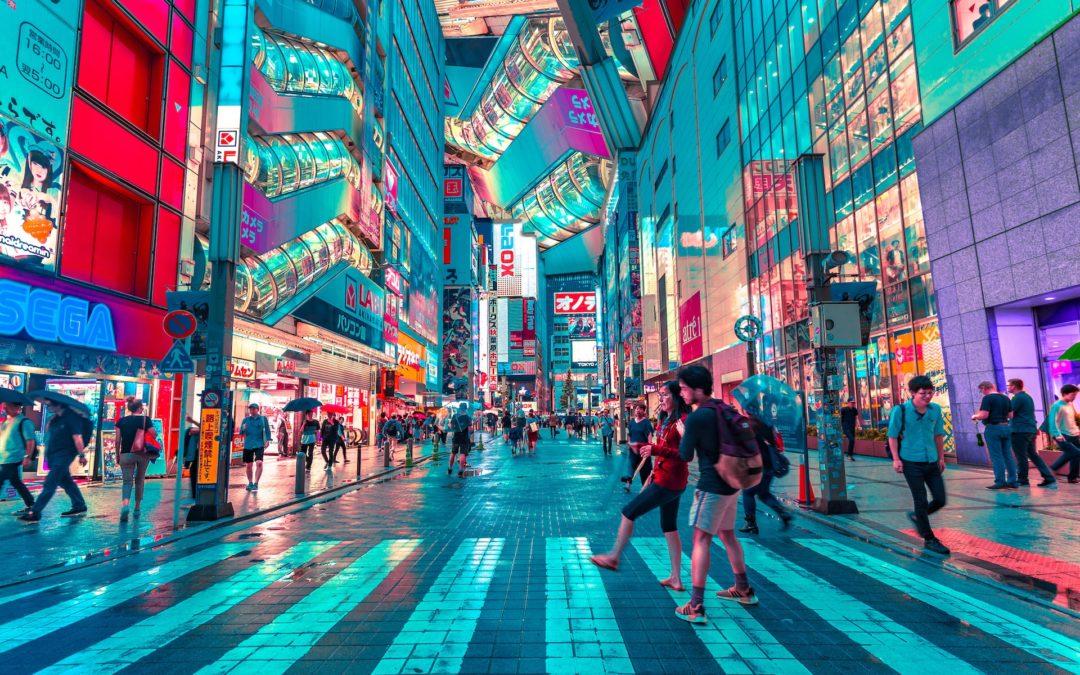Tokyo, often referred to as an Alpha+ city by the Globalization and World Cities Research Network, stands as the world’s largest urban economy, boasting a remarkable GDP of USD 1.6 trillion, a position it has held for the past five decades. Situated in the southeastern region of Japan’s mainland Honshu, Tokyo graces the shores of Tokyo Bay, overlooking the vast expanse of the Pacific Ocean. Tokyo is renowned for its distinction as the most densely populated metropolitan area in the nation, with a staggering 37,194,000 residents as of 2023. In this article, we will delve into the intricacies of life in Tokyo, helping you determine if this vibrant city aligns with your future aspirations.
Understanding Tokyo
Tokyo, a city of rich history and unparalleled modernity, beckons with its fascinating transformation from Edo, a medieval fishing village, to the vibrant metropolis we know today. This section provides a comprehensive overview of Tokyo’s historical roots, its diverse geography, and its profound cultural and global significance.
Historical Background of Tokyo’s Transformation from Edo to Modern Metropolis
Nestled on the eastern coast of Honshu, the largest of Japan’s four main islands, Tokyo’s history is an awe-inspiring tale of evolution. Originally known as Edo, the city’s journey to becoming the Japanese capital began in the early 17th century when Tokugawa Ieyasu, the founder of the Tokugawa shogunate, established it as his seat of power. Edo’s strategic location, nestled alongside the Sumida River and Tokyo Bay, was chosen for its defensibility.
Throughout the Edo period (1603-1868), Japan experienced a period of relative peace and isolation under the Tokugawa rule. Edo flourished as a center of culture, commerce, and governance. However, it wasn’t until the Meiji Restoration in the late 19th century that Tokyo truly transformed. Emperor Meiji relocated the imperial capital from Kyoto to Edo, renaming it Tokyo, which means “Eastern Capital.” This shift marked the beginning of Tokyo’s rapid modernization and emergence as a global powerhouse.
In the 20th century, Tokyo witnessed periods of tremendous growth and rebuilding, particularly following the devastation of World War II. The city’s remarkable resilience and unwavering spirit led to its emergence as a leading global financial, technological, and cultural hub.
Tokyo’s Geography and Divisions (23 Wards, Central Districts, Suburbs)
Tokyo’s vastness can be both awe-inspiring and a little overwhelming, but understanding its geography is crucial for navigating the city effectively. Tokyo is divided into several administrative units, with its core comprised of 23 special wards, each with its own distinct character and charm.
1. The 23 Special Wards: These wards, often likened to individual cities, make up the heart of Tokyo. From the bustling commercial districts of Shinjuku and Shibuya to the serene residential neighborhoods like Setagaya and Bunkyo, each ward offers a unique living experience.
2. Central Districts: Beyond the 23 wards, Tokyo extends into central districts like Chiyoda (home to the Imperial Palace), Minato (featuring the iconic Tokyo Tower), and Chuo (known for its historic neighborhoods and Tsukiji Fish Market). These districts serve as hubs for business, culture, and government.
3. Suburbs: Tokyo’s suburbs offer a quieter and more suburban lifestyle. Areas like Saitama, Yokohama, and Chiba provide a balance between urban amenities and a calmer living environment. These suburbs are well-connected to central Tokyo via an extensive transportation network.
Tokyo’s Place in Japanese Culture and Global Significance
Tokyo is not just Japan’s capital; it is the heart of Japanese culture and a global beacon of innovation and influence.
- Cultural Epicenter: Tokyo is a melting pot of traditional Japanese culture and contemporary trends. You can explore ancient temples in Asakusa, appreciate the performing arts in Kabukicho, or immerse yourself in modern pop culture in Akihabara.
- Global Business Hub: Tokyo boasts a thriving economy, housing the headquarters of some of the world’s most prominent corporations. The city’s financial districts, such as Marunouchi and Otemachi, play a pivotal role in the global economy.
- Innovation and Technology: Tokyo is at the forefront of technological advancements, with Akihabara’s electronics shops and innovation hubs like Odaiba showcasing the latest in robotics and futuristic developments.
- Global Influence: As a global city, Tokyo holds considerable diplomatic and cultural influence. It hosts numerous international events, such as the Olympics and various cultural festivals, drawing people from around the world.
Popular Attractions in Tokyo
In this section, we are going to list the different attractions that can be found and can be enjoyed in Tokyo.
- Shibuya Crossing – A true icon of Tokyo’s urban energy, Shibuya Crossing is the world’s busiest pedestrian crossing. It has a thousand of people crossing in all directions, surrounded by different billboards and advertisements.
- Tokyo Disneyland – this popular theme park offers a magical experience for children and young at heart.
- Senso-ji Temple – this temple is the oldest in Tokyo and it especially holds cultural and historical significance.
- Tokyo Tower – It is a landmark in Tokyo inspired by the Eiffel Tower, Tokyo Tower offers breathtaking city views from its observation decks and is most beautiful especially when lit up at night.
- Tsukiji Market – Even though the famous Tsukiji Fish Market has moved, the outer market still has a lot of delicious fish, street food, and other culinary treats. It’s a great place to enjoy fresh sushi and other Japanese foods.
Facts about Tokyo
- Technology Hub: Tokyo is a world leader in technology, and its innovations are known all over the world. From futuristic architecture to high-tech robots and trains, the city is the best example of what is technology progress today.
- Transportation – The sophisticated transportation system in Tokyo works very well, making it easy for both locals and visitors to get around the city. The trains, buses, and subways run on time, which shows how the Japanese value their time.
- Fashion – Shibuya and Harajuku show how exciting Tokyo’s fashion scene is making it a global style hub.
- Neon nightscape – At night, Tokyo comes to life with a sea of bright lights. The brightly lit buildings, busy nightlife, and famous sites like the Tokyo Tower make for a night you’ll never forget.
- Retailing – Tokyo is a paradise for people especially those who love to shop. From the high-end Ginza to the popular Shibuya, the city has a lot of places to shop that offer a mix of local and foreign brands.
- Artistic – Tokyo has a lot of art galleries and museums that show traditional Japanese art, modern art, and works from other countries. The teamLab Borderless digital art museum is a must-see immersing in the art of Japanese.
- Respectful Etiquette- Manners and good behavior are very important in Japanese society such as being polite, clean, and organized, which adds to the general sense of harmony in the city.
Living in Tokyo for Expats
For ex-pats who want to have a great nightlife, the night lifestyle of Tokyo is engaging for locals and ex-pats. It is home to world-class restaurants and shopping centers perfect for expats who can afford this lifestyle. Although, living in the city could be slightly different. Tokyo was ranked 42 out of 50 countries according to the result of the annual Expat City Ranking by InterNation.The main cause of this below ranking is the cost of accommodation and transport.
Here is the list of the accommodation costs in the Tokyo guide:
- Hostels – First, if you want to save money, dorms, and cheap hotels are good options. Hostels can charge anywhere from 2,000 to 5,000 yen per night ($18 to $45) for a bed in a shared room. Budget hotels have private rooms, and the price per night can range from 5,000 to 10,000 yen, based on where the hotel is and what it has to offer.
- Business Hotels: These mid-range hotels usually have modern amenities and offer ease and convenience. A basic room can cost anywhere from 8,000 to 15,000 yen per night. People who are traveling for work or pleasure often stay at business hotels.
- Capsule hotels – In addition, capsule hotels in Japan are small places to sleep. Most rooms cost between 2,000 and 5,000 yen per night which is why they are often chosen by people who are traveling alone and have no extras.
- Airbnb and Vacation Rentals: In addition, rooms such as private and whole flats or houses are shared rooms for rent. For a private room, prices can run from 3,000 to 15,000 yen per night, and for a whole house, they can start at between 8,000 and 20,000 yen per night.
- Ryokans and Luxury Hotels: Both Ryokans, which are traditional Japanese inns, and luxury hotels give a high-end experience. Traditional ryokans can cost between 20,000 and 40,000 yen per night, while luxury hotels can cost between 20,000 and well over 50,000 yen per night.
- Long-Term Rentals: Furthermore, if you’re going to be in Tokyo for a long time, you can rent an apartment. The rent for a one-bedroom apartment can start anywhere from 80,000 to 150,000 yen per month, depending on where it is and what it has to offer.
Pros and Cons Living in Tokyo
Pros:
- Job Opportunities: Tokyo is the economic heart of Japan, it truly offers plenty of job opportunities across different industries.
- Cultural Richness: Tokyo is a cultural hub where tradition and modernity coexist. In fact, you’ll have access to historical sites, traditional festivals, and contemporary art scenes, offering a well-rounded cultural experience.
- Public Transportation: Tokyo’s trains and subways serve as components of an efficient and vast public transportation system that makes it easy to get around the city.
- Safety: Tokyo is generally safe because it has a low crime rate environment. You can comfortably navigate the city without constant concern for personal safety.
- Entertainment and Nightlife: Tokyo’s nightlife is legendary, with endless entertainment options. Also, there are world-class venues to enjoy such as restaurants bars-themed cafes, and karaoke venues. There is always something exciting to do.
- Food Trips – Tokyo is a paradise for people who love to eat. From food stands on the street to fancy restaurants, you can try a wide range of Japanese and international dishes.
Cons:
- Cost of Living: Tokyo’s cost of living can be high. Accommodation, dining out, and daily expenses may require careful budgeting, especially in central areas.
- Crowded places: Tokyo has a lot of people, so its trains, streets, and public places are often full. This might be too much for people who like more open spaces.
- Language Barrier: Japanese is the primary language besides the English language in tourist areas. Adjusting to daily life can be challenging if you’re not familiar with the language.
- Work Culture: Japan’s work culture can be demanding, with long working hours and a strong emphasis on dedication. Having a work-life balance might be challenging in particular.
- Natural Disasters: Tokyo is prone to earthquakes and typhoons, which are both types of natural disasters. Even though the city is ready, these things can still be scary.
- Cultural Difference – However, the rules and customs in Tokyo may be different from your culture which is why it may take a while for you to adapt.
What is it like living in Tokyo? Well, it depends on your preference. Living in Tokyo has pros and cons. In between the neon-lit streets and tall buildings, you’ll find a city that cares about both its history and its future. Still, in the middle of all the excitement, people must deal with crowded streets and small living spaces while taking part in a society that values respect, harmony, and hard work. Tokyo’s lively energy and complicated charm make it a fascinating place to explore, adapt, and find new things.
Here is a video for a better guide to what is a typical neighborhood in Tokyo.
Read also: Living in London: Pros and Cons
The Most Popular on BitGlint

40 Social Dilemma Examples in the World & Real Life
Social dilemmas are everywhere. They shape the choices we make at work, in our communities, and even on a global...

30 Favor Examples & Definition
Doing a favor means helping someone without expecting anything in return. It’s an act of kindness that can strengthen...

30 Naivety Examples & Definition
Naivety is something most people experience at some point in their lives. It often starts in childhood, but for some,...

20 Chronology Examples & Meaning
Chronology is something we use more than we realize. It shows up in conversations, in how we remember the past, and in...

30 Wishful Thinking Examples & Meaning
Wishful thinking is something we all do at some point. You hope things will turn out fine—even if there’s no real...

20 Examples of Gravity & What Gravity Really Is
Gravity is one of the most important forces in the universe, but many people don’t fully understand what it really is...

20 Examples of Secondary Consumers in the Food Chain
Secondary consumers are animals that eat other animals—usually herbivores that feed on plants. They’re an important...
Get Inspired with BitGlint

